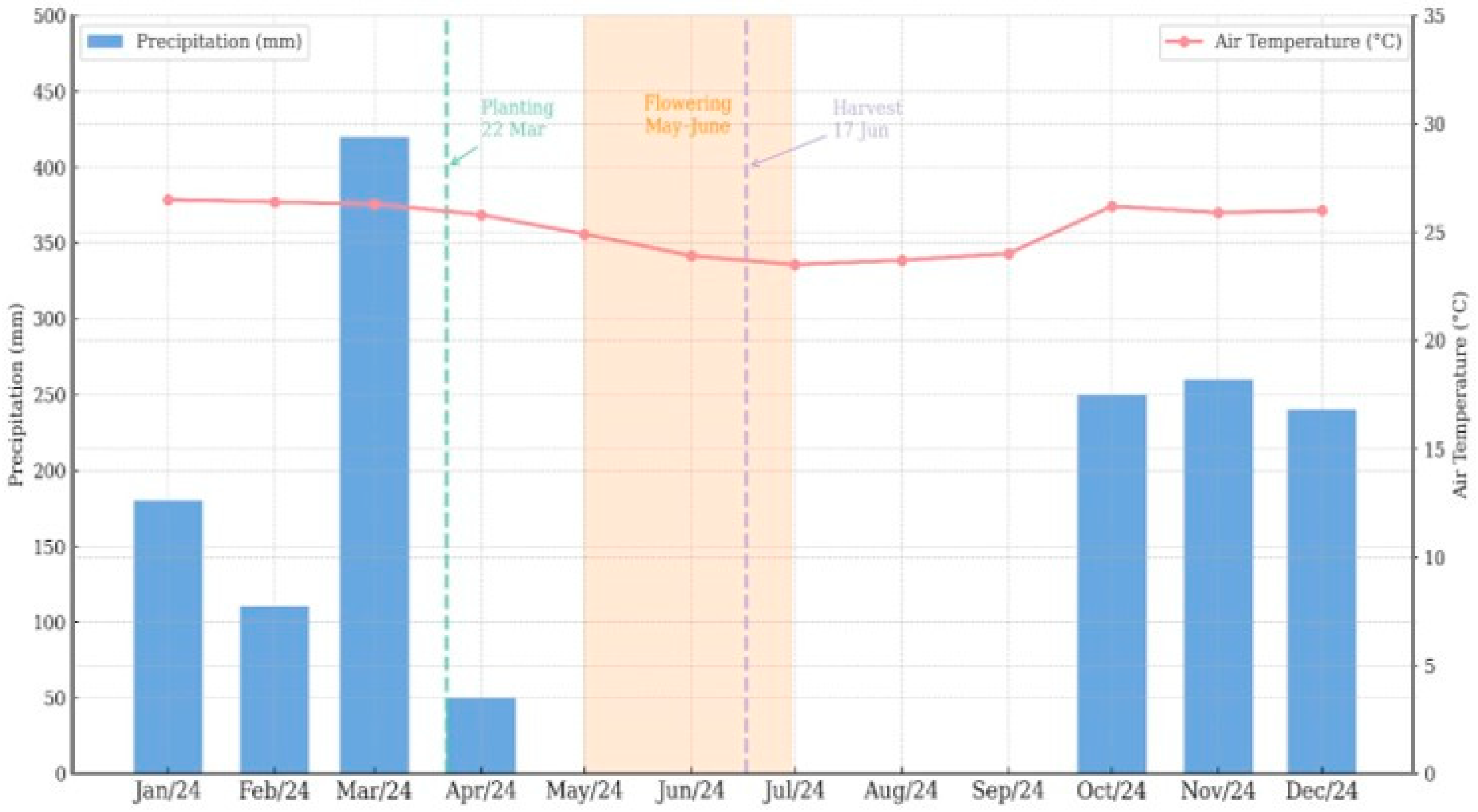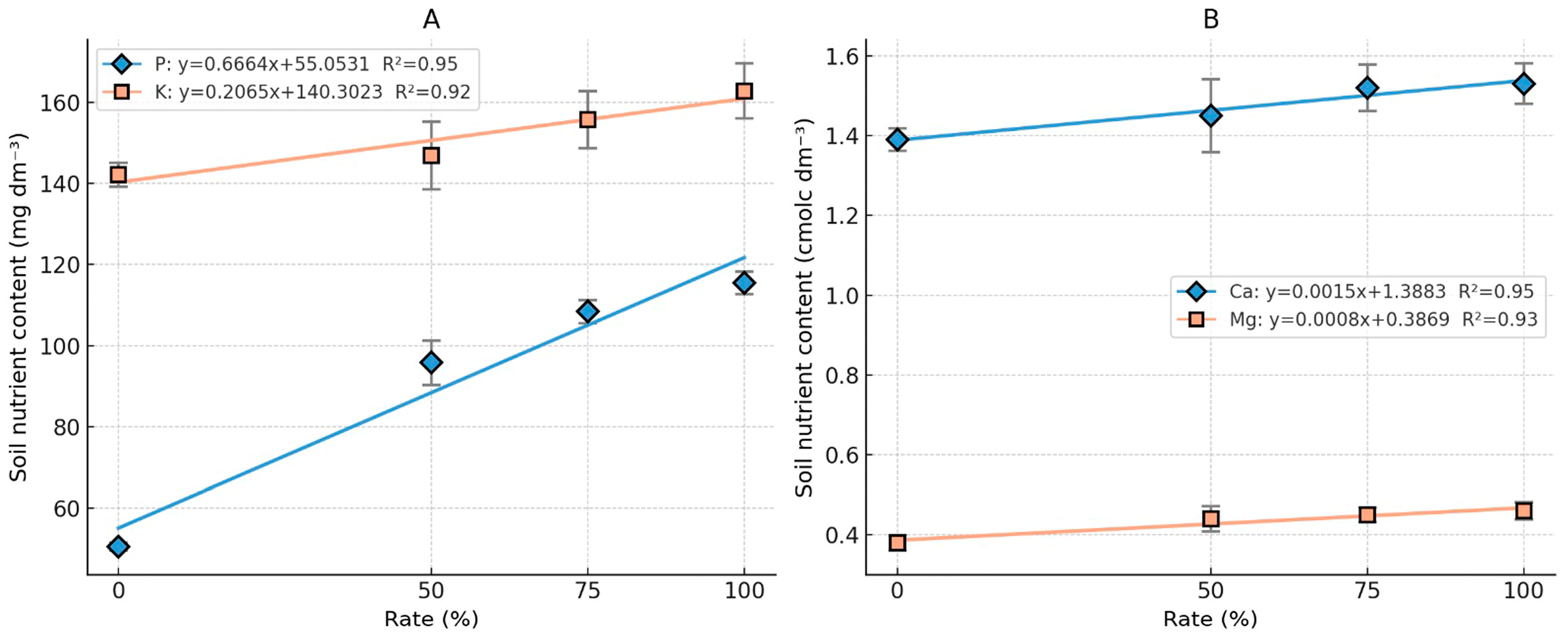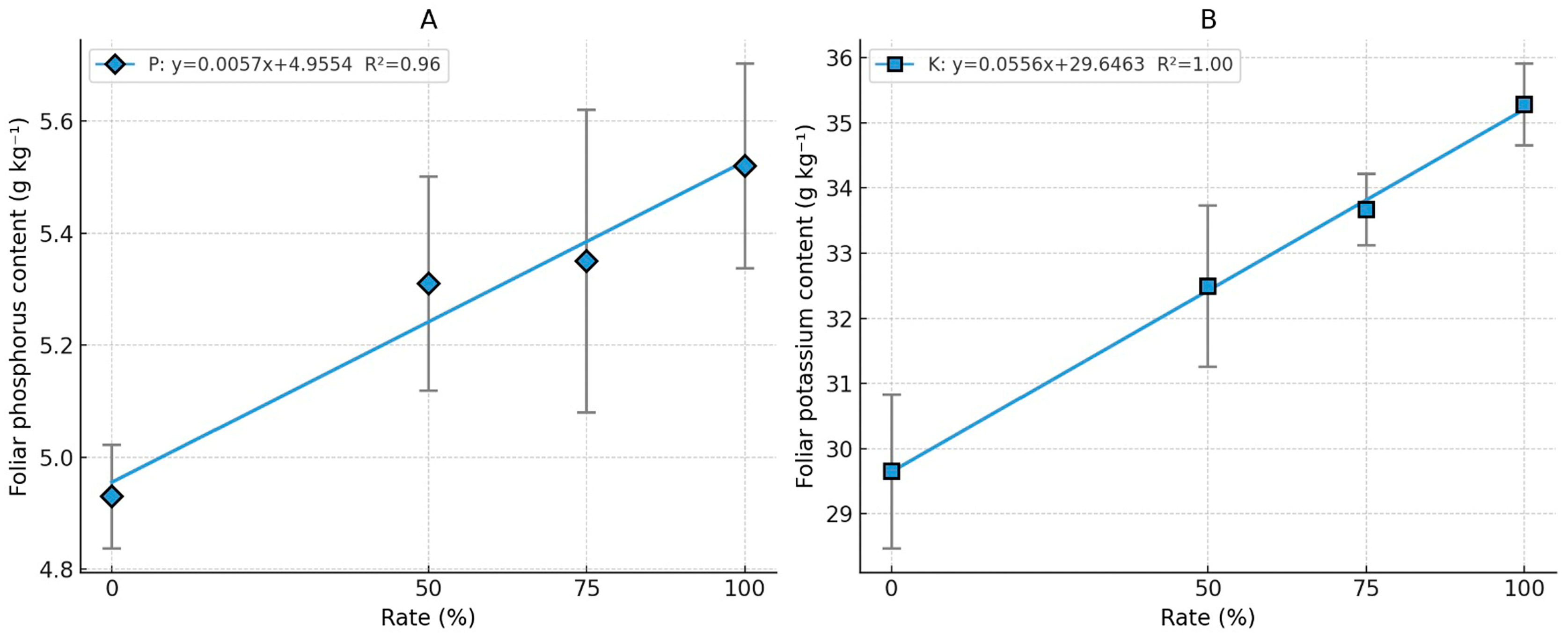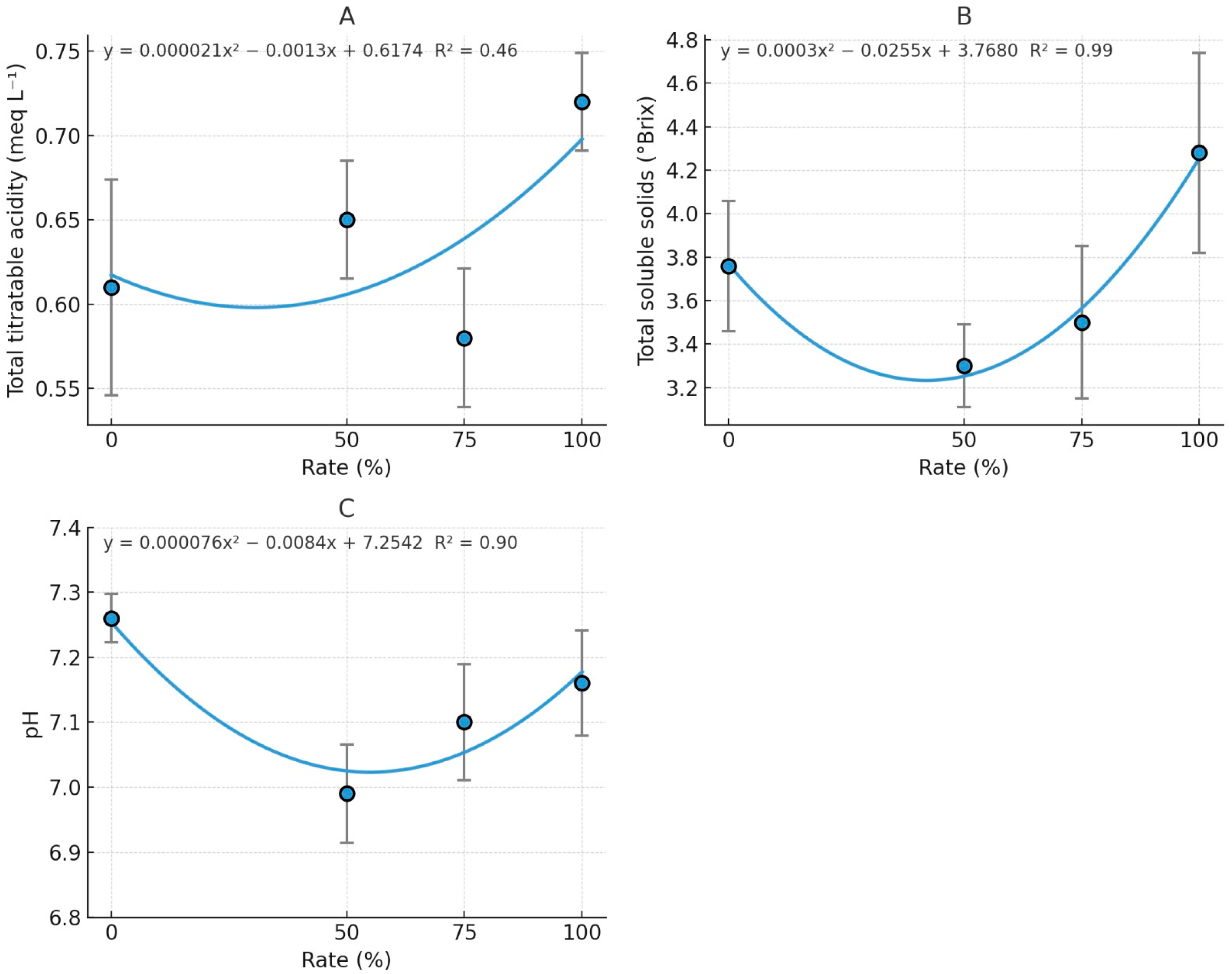Agronomic and Physicochemical Quality of Broccoli Cultivated Under Different Fertilizers and Phosphorus Rates
Abstract
1. Introduction
2. Materials and Methods
2.1. Characterization of the Area
2.2. Experimental Design and Treatments
2.3. Additional Information
2.4. Evaluations
2.5. Statistical Analysis
3. Results and Discussion
3.1. Agronomic Attributes
3.2. Physicochemical Attributes
4. Conclusions
Author Contributions
Funding
Data Availability Statement
Acknowledgments
Conflicts of Interest
References
- Folegatti, M.V.; Silva, L.G.; Ferreira, R. Análise de mercado e produtividade de brócolis. Agric. Econ. Rev. 2021, 29, 34–50. [Google Scholar]
- Li, H.; Xia, Y.; Liu, H.Y.; Guo, H.; He, X.Q.; Liu, Y.; Wu, D.T.; Mai, Y.H.; Li, H.B.; Zou, L.; et al. Nutritional values, beneficial effects, and food applications of broccoli (Brassica oleracea var italica). Trends Food Sci. Technol. 2022, 119, 288–308. [Google Scholar] [CrossRef]
- Montaner, C.; Mallor, C.; Laguna, S.; Zufiaurre, R. Bioactive compounds, antioxidant activity, and mineral content of bróquil: A traditional crop of Brassica oleracea var. italica. Front. Nutr. 2023, 9, 1–14. [Google Scholar] [CrossRef] [PubMed]
- Nagraj, G.S.; Chouksey, A.; Jaiswal, S.; Jaiswal, A.K. Broccoli. In Nutritional Composition and Antioxidant Properties of Fruits and Vegetables; Jaiswal, A.K., Ed.; Academic Press: Cambridge, MA, USA, 2020; pp. 5–17. [Google Scholar] [CrossRef]
- Gudiño, I.; Martín, A.; Casquete, R.; Prieto, M.H.; Ayuso, M.C.; Córdoba, M.G. Evaluation of broccoli (Brassica oleracea var. italica) crop by-products as sources of bioactive compounds. Sci. Hortic. 2022, 304, 111284. [Google Scholar] [CrossRef]
- Santos, C.A.; Cruz, L.C.C.D.; Carmo, M.G.F. Brócolis: Mercado Segue Aquecido. R. Camp. Neg. 2024, 1, 1–3. [Google Scholar]
- Blind, A.D.; Costa, I.B.; Barboza, E.; Moline, E.F.V.; Figueiredo, J.N.R.; Silva Filho, D.F. Índice de rendimento em cultivares de brócolis tipo ramoso sob manejos de fertilização na Amazônia central. Sci. Plena 2015, 11, 070201. [Google Scholar]
- Ferreira Junior, J.J.; Torres, J.L.R.; Charlo, H.C.O.; Orioli Júnior, V.; Loss, A.; Barreto, A.C. No-till broccoli production using different cover crop residues and nitrogen doses. Hortic. Bras. 2023, 41, e2479. [Google Scholar] [CrossRef]
- Guareschi, R.F.; Pereira, M.G.; Perin, A. Adsorption of P and forms of iron in no-tillage areas in the Cerrado biome. Acta Sci. Agron. 2015, 37, 109–116. [Google Scholar] [CrossRef]
- Torres, J.L.R.; Gomes, F.R.C.; Barreto, A.C.; Tamburús, A.Y.; Vieira, D.M.S.; Souza, Z.M.; Mazetto Júnior, J.C. Application of different cover crops and mineral fertilizer doses for no-till cultivation of broccoli cauliflower and cabbage. Aust. J. Crop Sci. 2017, 11, 1339–1345. [Google Scholar] [CrossRef]
- Novais, R.F.; Smyth, T.J.; Nunes, F.N. Fósforo. In Fertilidade do Solo; Novais, R.F., Alvarez V., V.H., Barros, N.F., Fontes, R.L.F., Cantarutti, R.B., Neves, J.C.L., Eds.; SBCS: Viçosa, Brazil, 2007; pp. 471–550. [Google Scholar]
- Broggi, F.; Freire, F.J.; Freire, M.B.G.S.; Nascimento, C.W.A.; Oliveira, A.C. Avaliação da disponibilidade, adsorção e níveis críticos de fósforo em diferentes solos. Rev. Ceres 2010, 57, 247–252. [Google Scholar] [CrossRef]
- Vieira, D.M.S.; Torres, J.L.R.; Camargo, R.; Silva, A.A.; Lana, R.M.Q.; Charlo, H.C.O.; Lemes, E.M.; Carvalho, E.R. Residual effects of phosphorus and micronutrients in vegetable growing areas under different organomineral fertilizer doses. Horticulturae 2023, 9, 761. [Google Scholar] [CrossRef]
- Torres, J.L.R.; Almeida, D.D.A.; Pereira, M.G.; Guardieiro, L.V.F.; Loss, A.; Lourenzi, C.R.; Gonzalez, A.P.; Carvalho, M.; Vieira, D.M.S. Phosphorus Fractionations and Availability in Areas under Different Management Systems in the Cerrado. Agronomy 2023, 13, 966. [Google Scholar] [CrossRef]
- Cardoso, A.I.I.; Silva, P.N.L.; Fernandes, D.M.; Lanna, N.B.L.; Colombari, L.F.; Nakada-Freitas, P.G. Residual effect of phosphorus sources on the presence and absence of organic compost in the production of beet and chicory in subsequent cultivation of broccoli. Hortic. Bras. 2024, 42, e2543. [Google Scholar] [CrossRef]
- Silva, T.P.; Pinto, L.A.S.R.; Oliveira, C.C.L.; Ferreira, F.; Trogello, E.; Pereira, M.G. Phosphorus fractions in different management systems in the Cerrado Goiano. Rev. Ambient. Água 2025, 20, e3057. [Google Scholar] [CrossRef]
- Filgueira, F.A.R. Novo Manual de Olericultura: Agrotecnologia Moderna na Produção e Comercialização de Hortaliças, 3rd ed.; UFV: Viçosa, MG, Brazil, 2013; p. 423. [Google Scholar]
- Oliveira, C.P.; Souza, F.F.; Cunha, M.S.; Silva, F.F. Fósforo e qualidade nutricional em brássicas. J. Plant Nutr. 2020, 24, 34–42. [Google Scholar]
- Aguilar, A.S.; Cardoso, A.F.; Lima, L.C.; Luz, J.M.Q.; Rodrigues, T.; Lana, R.M.Q. Influence of organomineral fertilization in the development of the potato crop CV. Cupid. Biosci. J. 2019, 35, 199–210. [Google Scholar] [CrossRef]
- Ferrari, A.C.; Fagundes, H.S.; Pereira, M.G.; Zonta, E. Organomineral fertilizers from oilseed pies. Rev. Gestão Soc. Ambient. 2024, 18, e04680. [Google Scholar] [CrossRef]
- Silva, L.G.; Reginaldo, C.; Lana, R.M.Q.; Delvaux, J.C.; Fagan, E.B.; Machado, V.J. Biochemical changes and development of soybean with use of pelletized organominerals fertilizer based of sewage sludge and filter cake. Acta Sci. Agron. 2020, 42, e44249. [Google Scholar] [CrossRef]
- Teixeira, P.C.; Loiola, J.A.D.; Dias, R.C.; Alonso, J.M.; Zonta, E.; Straliotto, R. Evaluation of different phosphate organomineral fertilizers in maize cultivation on soils with contrasting phosphorus contents. Int. J. Recycl. Org. Waste Agric. 2025, 14, 1–9. [Google Scholar] [CrossRef]
- Almeida, A.R.; Souza, B.F.; Lima, C.G.; Ribeiro, D.H.; Oliveira, E.J. Correção de fósforo em solos do cerrado para alta produtividade de hortaliças. Rev. Bras. Agr. Sust. 2016, 12, 250–256. [Google Scholar]
- Aguilar, A.S.; Silva, A.C.O.; Oliveira, R.C.; Silva, J.E.R.; Luz, J.M.Q.; Castro, L.H.S. Use of fertilizers and growth regulators in the production of broccoli seedlings. Pesqui. Agr. Per. 2017, 22, e201704. [Google Scholar] [CrossRef]
- Rodrigues, M.; Pavinato, P.S.; Withers, P.J.A.; Teles, A.P.B.; Herrera, W.F.B. Legacy phosphorus and no tillage agriculture in tropical oxisols of the Brazilian savanna. Sci. Total Environ. 2016, 542, 1050–1061. [Google Scholar] [CrossRef] [PubMed]
- Altieri, M.A.; Nicholls, C.I. Soil fertility management and insect pests: Harmonizing soil and plant health in agroecosystems. Soil Tillage Res. 2003, 72, 203–211. [Google Scholar] [CrossRef]
- Storck, C.R.; Nunes, G.L.; Oliveira, B.B.; Basso, C. Folhas, talos, cascas e sementes de vegetais: Composição nutricional, aproveitamento na alimentação e análise sensorial de preparações. Cienc. Rural 2013, 43, 537–543. [Google Scholar] [CrossRef]
- Ferreira, T.A.; Silva, C.O.; Pascoal, G.B. Analise físico-química em repolho branco (Brassica oleraceae) minimamente processado durante o acondicionamento sob refrigeração. Linkania 2014, 1, 59–72. [Google Scholar]
- Ornellas, H.L. Seleção e Preparo de Alimentos, 8th ed.; Atheneu: São Paulo, SP, Brazil, 2007; pp. 158–164. [Google Scholar]
- Torres, J.L.R.; Gomes, F.R.C.; Barreto, A.C.; Orioli Júnior, V.; França, G.D.; Lemes, E.M. Nutrient cycling of different plant residues and fertilizer doses in broccoli cultivation. Hortic. Bras. 2021, 39, 11–19. [Google Scholar] [CrossRef]
- Santos, H.G.; Jacomine, P.K.T.; Anjos, L.H.C.; Oliveira, V.A.; Lumbreras, J.F.; Coelho, M.R.; Almeida, J.A.; Cunha, T.J.F.; Oliveira, J.B. Sistema Brasileiro de Classificação de Solos, 5th ed. rev. e ampl.; Embrapa: Brasília, Brazil, 2018; p. 356. [Google Scholar]
- Beck, H.E.; Zimmermann, N.E.; McVicar, T.R.; Vergopolan, N.; Berg, A.; Wood, E.F. Present and future Köppen-Geiger climate classification maps at 1-km resolution. Sci. Data 2018, 5, 180214. [Google Scholar] [CrossRef] [PubMed]
- Inmte. Climatologia do cerrado brasileiro. In Relatório Técnico 2024; Inmte: Brasília, Brazil, 2024. Available online: https://portal.inmet.gov.br/servicos/gr%C3%A1ficos-climatol%C3%B3gicos (accessed on 5 June 2025).
- Ribeiro, A.C.; Guimarães, P.T.G.; Alvarez, V.V.H. Recomendações para o Uso de Corretivos e Fertilizantes em Minas Gerais; UFV: Viçosa, MG, Brazil, 1999; p. 359. [Google Scholar]
- Trani, P.E.; Raij, B. Hortaliças. Recomendações de Adubação e Calagem para o Estado de São Paulo; Raij, B., Cantarella, H., Quaggio, J.A., Furlani, A.M.C., Eds.; IAC: Campinas, SP, Brazil, 1997; pp. 157–163.
- Martinez, H.E.P.; Carvalho, J.G.; Souza, R.B. Diagnose Foliar. Recomendações para o Uso de Corretivos e Fertilizantes em Minas Gerais: 5ª aproximação; Ribeiro, A.C., Guimarães, P.T.G., Alvarez, V.V.H., Eds.; UFV: Viçosa, Brazil, 1999; pp. 143–168. [Google Scholar]
- Teixeira, P.C.; Donagemma, G.K.; Fontana, A.; Teixeira, W.G. Manual de Métodos de Análise de Solos, 3rd ed. rev. e ampl.; Embrapa: Rio de Janeiro, Brazil, 2017; p. 573. [Google Scholar]
- Lees, R. Food Analysis: Analytical and Quality Control Methods for the Food Manufacturer and Buyer, 3rd ed.; Leonard Hill Books: London, UK, 1975; p. 245. [Google Scholar]
- Association of Official Analytical Chemistry. AOAC—2005 Official Methods of Analysis of the Association of Official Analytical Chemistry, 18th ed.; Association of Official Analytical Chemistry: Washington, DC, USA, 2005; p. 1015. [Google Scholar]
- Instituto Adolfo Lutz—IAL. Métodos Físico-Químicos para Análises de Alimentos, 4th ed.; IAL: São Paulo, Brazil, 2008; p. 1020. [Google Scholar]
- Hunter, J.D. Matplotlib: A 2D graphics environment. Comp. Sci. Eng. 2007, 9, 90–95. [Google Scholar] [CrossRef]
- Barbosa, J.C.; Maldonado Júnior, W. Software AgroEstat: Sistema de Análises Estatísticas de Ensaios Agronômicos; Universidade Estadual Paulista, Faculdade de Ciências Agrárias e Veterinárias, Campus de Jaboticabal: Jaboticabal, Brazil, 2009. [Google Scholar]
- Figueiredo, C.C.; Barbosa, D.V.; Oliveira, A.S.; Fagioli, M.; Sato, J.H. Adubo fosfatado revestido com polímero e calagem na produção e parâmetros morfológicos de milho. Rev. Ciênc. Agron. 2012, 43, 446–452. [Google Scholar] [CrossRef]
- Cardoso, A.I.I.; Silva, P.N.L.; Colombari, L.F.; Lanna, N.B.L.; Fernandes, D.M. Phosphorus sources associated with organic compound in broccoli production and soil chemical attributes. Hortic. Bras. 2019, 37, 228–233. [Google Scholar] [CrossRef]
- Brady, N.C.; Weil, R. Elementos da Natureza e Propriedades dos Solos, 3rd ed.; Bookman: São Paulo, SP, Brazil, 2013; p. 716. [Google Scholar]
- Souza Júnior, R.F.; Oliveira, F.H.T.; Santos, H.C.; Freire, F.J.; Arruda, J.A. Frações de fósforo inorgânico do solo e suas correlações com o fósforo quantificado por extratores e pelo milho. Rev. Bras. Ciênc. Solo 2012, 36, 159–169. [Google Scholar] [CrossRef]
- Casali, C.A.; Tiecher, T.; Kaminski, J.; Santos, D.R.D.; Calegari, A.; Piccin, R. Benefícios do uso de plantas de cobertura de solo na ciclagem de fósforo. In Manejo e Conservação do Solo e da Água em Pequenas Propriedades Rurais no sul do Brasil: Práticas Alternativas de Manejo Visando a Conservação do Solo e da Água; UFRGS: Porto Alegre, Brazil, 2016; pp. 23–33. [Google Scholar]
- Alvarez, V.V.H.; Novais, R.F.; Barros, N.F.; Cantarutti, R.B.; Lopes, A.S. Interpretação dos resultados das análises de solos. In Recomendações para o Uso de Corretivos e Fertilizantes em Minas Gerais—5ª Aproximação; Ribeiro, A.C., Guimarães, P.T.G., Alvarez, V.V.H., Eds.; Comissão de Fertilidade do Solo do Estado de Minas Gerais: Viçosa, MG, Brasil, 1999; pp. 25–32. [Google Scholar]
- Loss, A.; Pereira, M.G.; Beutler, S.J.; Perin, A.; Piccolo, M.C.; Assunção, S.A.; Zonta, E. The impact of agricultural systems in the soil organic matter content in Brazilian Cerrado. Int. J. Res. Granthaalaysh 2019, 7, 220–244. [Google Scholar] [CrossRef]
- Vieira, D.M.S.; Camargo, R.; Franco, M.H.R.; Orioli Júnior, V.; Loss, A.; Charlo, H.C.O.; Domingos Júnior, F.A.; Torres, J.L.R. Broccoli Cultivation Under Different Sources and Rates of Specialty Phosphorus Fertilizers in the Brazilian Cerrado. Horticulturae 2025, 11, 631. [Google Scholar] [CrossRef]
- Vieira, D.M.S.; Camargo, R.; Torres, J.L.R.; Silva, A.A.; Lana, R.M.Q.; Carvalho, F.J. Growing vegetables in succession in different soils and doses of phosphorus in an organomineral fertilizer. Rev. Bras. Eng. Agr. Ambient. 2020, 24, 806–813. [Google Scholar] [CrossRef]
- Fageria, N.K. Nutrient interactions in crop plants. J. Plant Nutr. 2001, 24, 1269–1290. [Google Scholar] [CrossRef]
- Sousa, L.T.; Ferraz, E.S.; Monteiro, F.A.; Andrade, L.L.; Guedes, E.R. Fertilizantes organominerais e dinâmica do fósforo. Rev. Agr. Sust. 2020, 14, 120–132. [Google Scholar]
- Malavolta, E. Manual de Nutrição Mineral de Plantas; Editora Agronômica Ceres: São Paulo, SP, Brazil, 2006; p. 638. [Google Scholar]
- Aquino, L.A.; Puiatti, M.; Lélis, M.M.; Pereira, P.R.G.; Pereira, F.H.F. Produção de biomassa, teor e exportação de macronutrientes em plantas de repolho em função de doses de N e de espaçamentos. Ciênc. Agrotec. 2009, 33, 1295–1300. [Google Scholar] [CrossRef]
- Alves, A.U.; Prado, R.M.; Correia, M.A.R.; Gondim, A.R.O.; Cecílio Filho, A.B.; Politi, L.S. Cauliflower cultivated in substrate: Progress of absorption of macro and micronutrients. Ciênc. Agrotec. 2011, 35, 45–55. [Google Scholar] [CrossRef]
- Fernandes, A.M.; Soratto, R.P.; Evangelista, R.M.; Job, A.L.G. Influência do fósforo na qualidade e produtividade de tubérculos de cultivares de batata de duplo propósito. Hortic. Bras. 2016, 34, 346–355. [Google Scholar] [CrossRef][Green Version]
- Mcdonald, M.B. Seed deterioration. Physiology, repair ande assessment. Seed Sci. Tech. 1999, 27, 177–237. [Google Scholar][Green Version]
- Rinaldi, M.M.; Benedetti, B.C.; Sarantópoulos, C.I.G.L.; Moretti, C.L. Estabilidade de repolho minimamente processado sob diferentes sistemas de embalagem. Food Sci. Technol. 2009, 29, 310–315. [Google Scholar] [CrossRef]
- Fernandes, A.F.; Pereira, J.; Germani, R.; Oiano-Neto, J. Efeito da substituição parcial da farinha de trigo por farinha de casca de batata (Solanum tuberosum Lineu). Food Sci. Technol. 2008, 28, 56–65. [Google Scholar] [CrossRef]





| Layer | pH | Ca | Mg | Al | H + Al | P | K | S | SOC | |
|---|---|---|---|---|---|---|---|---|---|---|
| cm | H2O | SMP | cmolc dm−3 | mg dm−3 | g dm−3 | |||||
| 0–20 | 6.00 | 5.40 | 1.80 | 0.45 | 0.00 | 2.20 | 0.71 | 0.22 | 8.71 | 20.20 |
| B | Cu | Fe | Mn | Zn | ||||||
| mg dm−3 | ||||||||||
| 0.20 | 1.61 | 24.71 | 13.20 | 0.71 | ||||||
| Treatments | Agronomic Attributes | |||
|---|---|---|---|---|
| NL | HFM | HDM | YLD | |
| - | kg plant−1 | Mg ha−1 | ||
| Fertilizer (F) | ||||
| CMP | 25.81 | 0.69 c | 0.22 c | 20.62 c |
| PCMP | 26.19 | 0.86 b | 0.26 b | 21.43 b |
| GOF | 25.37 | 0.91 a | 0.29 a | 22.82 a |
| % | Rate (R) | |||
| 0 | 23.50 b | 0.46 c | 0.21 c | 19.26 b |
| 50 | 25.34 a | 0.80 b | 0.24 b | 20.59 a |
| 75 | 26.33 a | 0.97 a | 0.27 a | 21.04 a |
| 100 | 27.00 a | 0.98 a | 0.28 a | 21.85 a |
| F-test for F | 0.80 ns | 12.58 ** | 8.02 * | 8.46 * |
| F-test for R | 7.05 ** | 359.05 ** | 189.98 ** | 3.02 * |
| F-test for F × R | 0.79 ns | 18.76 ** | 4.47 ** | 17.86 ** |
| CV% F | 5.91 | 9.22 | 10.15 | 7.11 |
| CV% R | 6.97 | 4.76 | 10.39 | 4.80 |
| Treatment | Chemical Attributes | |||||
|---|---|---|---|---|---|---|
| pH | P | K | Ca | Mg | H + Al | |
| H2O | mg dm−3 | cmolc dm−3 | ||||
| Fertilizer (F) | ||||||
| CMP | 5.63 | 87.71 b | 150.91 b | 1.34 b | 0.39 b | 4.38 |
| PCMP | 5.65 | 88.81 b | 135.35 c | 1.53 a | 0.45 a | 4.28 |
| GOF | 5.62 | 101.09 a | 167.50 a | 1.55 a | 0.47 a | 4.38 |
| Rate (R) | ||||||
| 0 | 5.05 b | 50.51 d | 142.17 b | 1.39 b | 0.38 b | 4.05 b |
| 50 | 5.61 b | 95.78 c | 146.91 b | 1.45 b | 0.44 a | 4.40 a |
| 75 | 5.62 b | 108.39 b | 155.76 a | 1.52 a | 0.45 a | 4.45 a |
| 100 | 5.70 a | 115.47 a | 162.84 a | 1.53 a | 0.46 a | 4.47 a |
| F-test for F | 0.43 ns | 0.27 ** | 0.36 ** | 1.20 ** | 0.88 ** | 1.00 ns |
| F-test for R | 1.09 ** | 8.96 * | 16.31 ** | 22.10 ** | 9.76 * | 0.79 ** |
| F-test for F x R | 0.84 ns | 5.58 ** | 13.45 ** | 10.45 ** | 4.13 ** | 0.56 ns |
| CV% F | 1.12 | 10.74 | 9.84 | 6.66 | 12.10 | 6.10 |
| CV% R | 2.04 | 8.58 | 7.61 | 8.80 | 14.22 | 9.71 |
| Treatment | Nutritional Composition | ||
|---|---|---|---|
| N | P | K | |
| g kg−1 | |||
| Fertilizer (F) | |||
| CMP | 44.92 | 5.11 | 33.17 |
| PCMP | 46.39 | 5.08 | 31.87 |
| GOF | 49.19 | 5.63 | 33.28 |
| Rate (R) | |||
| 0 | 41.76 b | 4.93 b | 29.65 b |
| 50 | 41.94 b | 5.31 a | 32.49 a |
| 75 | 43.39 b | 5.35 a | 33.67 a |
| 100 | 60.24 a | 5.52 a | 35.28 a |
| F-test for F | 0.92 ns | 0.10 ns | 1.43 ns |
| F-test for R | 6.63 ** | 2.72 ** | 2.70 * |
| F-test for F x R | 1.92 ns | 3.98 * | 1.62 * |
| CV% F | 6.23 | 4.47 | 5.05 |
| CV% R | 9.76 | 13.59 | 8.72 |
| Fertilizer | Parameters Evaluated in Broccoli | ||||||||
|---|---|---|---|---|---|---|---|---|---|
| MOI | ASH | LIP | PROT | CF | TTA | TSS | pH | AA | |
| % | Meq L−1 | °Brix | mg 100 g−1 | ||||||
| Fertilizer (F) | |||||||||
| CMP | 89.28 | 8.82 | 3.54 | 2.77 | 15.02 | 0.64 | 4.34a | 6.93b | 17.11 |
| PCMP | 89.77 | 8.78 | 3.13 | 2.82 | 16.25 | 0.61 | 3.20b | 7.26a | 20.12 |
| GOF | 90.09 | 8.67 | 2.27 | 2.66 | 15.31 | 0.67 | 3.59b | 7.18a | 15.87 |
| % | Rate (R) | ||||||||
| 0 | 89.96 | 8.54 | 3.13 | 2.66 | 15.60 | 0.61b | 3.76 b | 7.26a | 16.95 |
| 50 | 89.71 | 8.87 | 3.28 | 2.78 | 15.07 | 0.65b | 3.30b | 6.99c | 15.94 |
| 75 | 89.05 | 8.52 | 3.29 | 2.80 | 16.25 | 0.58b | 3.50b | 7.10b | 18.88 |
| 100 | 90.13 | 9.06 | 3.55 | 2.75 | 15.19 | 0.72a | 4.28a | 7.16a | 19.03 |
| F-test for F | 0.93 ns | 0.16 ns | 7.15 ns | 0.83 ns | 2.08 ns | 1.18 ns | 13.54 * | 27.81 ** | 4.27 ns |
| F-test for R | 1.82 ns | 2.49 ns | 2.71 ns | 0.70 ns | 1.08 ns | 4.40 * | 4.76 * | 9.26 ** | 0.37 ns |
| F-test for F x R | 0.72 ns | 4.83 ns | 0.84 ns | 2.05 ns | 1.62 ns | 7.71 ** | 8.74 ** | 6.81 ** | 7.17 ns |
| CV% for F | 1.15 | 7.63 | 8.14 | 11.25 | 9.98 | 14.38 | 14.66 | 1.59 | 20.68 |
| CV% for R | 1.30 | 5.66 | 9.62 | 7.84 | 9.90 | 13.91 | 15.69 | 1.56 | 18.04 |
Disclaimer/Publisher’s Note: The statements, opinions and data contained in all publications are solely those of the individual author(s) and contributor(s) and not of MDPI and/or the editor(s). MDPI and/or the editor(s) disclaim responsibility for any injury to people or property resulting from any ideas, methods, instructions or products referred to in the content. |
© 2025 by the authors. Licensee MDPI, Basel, Switzerland. This article is an open access article distributed under the terms and conditions of the Creative Commons Attribution (CC BY) license (https://creativecommons.org/licenses/by/4.0/).
Share and Cite
Vieira, D.M.d.S.; Camargo, R.d.; Franco, M.H.R.; Orioli Júnior, V.; Oliveira, C.C.d.; Loss, A.; Domingos Júnior, F.A.; Silva, M.M.A.P.d.M.; Torres, J.L.R. Agronomic and Physicochemical Quality of Broccoli Cultivated Under Different Fertilizers and Phosphorus Rates. Horticulturae 2025, 11, 873. https://doi.org/10.3390/horticulturae11080873
Vieira DMdS, Camargo Rd, Franco MHR, Orioli Júnior V, Oliveira CCd, Loss A, Domingos Júnior FA, Silva MMAPdM, Torres JLR. Agronomic and Physicochemical Quality of Broccoli Cultivated Under Different Fertilizers and Phosphorus Rates. Horticulturae. 2025; 11(8):873. https://doi.org/10.3390/horticulturae11080873
Chicago/Turabian StyleVieira, Dinamar Márcia da Silva, Reginaldo de Camargo, Miguel Henrique Rosa Franco, Valdeci Orioli Júnior, Cintia Cristina de Oliveira, Arcângelo Loss, Fausto Antônio Domingos Júnior, Maytê Maria Abreu Pires de Melo Silva, and José Luiz Rodrigues Torres. 2025. "Agronomic and Physicochemical Quality of Broccoli Cultivated Under Different Fertilizers and Phosphorus Rates" Horticulturae 11, no. 8: 873. https://doi.org/10.3390/horticulturae11080873
APA StyleVieira, D. M. d. S., Camargo, R. d., Franco, M. H. R., Orioli Júnior, V., Oliveira, C. C. d., Loss, A., Domingos Júnior, F. A., Silva, M. M. A. P. d. M., & Torres, J. L. R. (2025). Agronomic and Physicochemical Quality of Broccoli Cultivated Under Different Fertilizers and Phosphorus Rates. Horticulturae, 11(8), 873. https://doi.org/10.3390/horticulturae11080873





